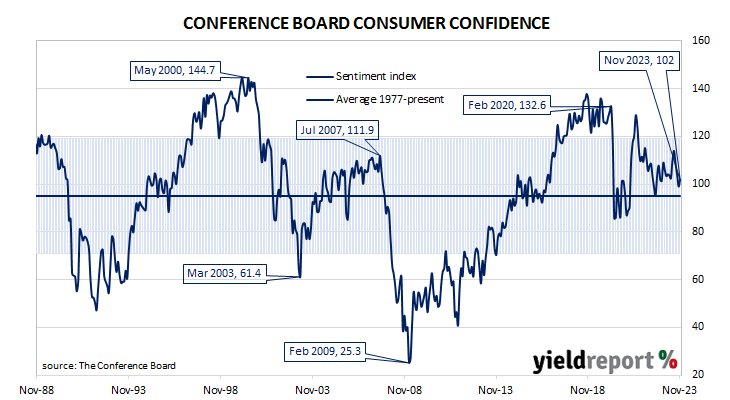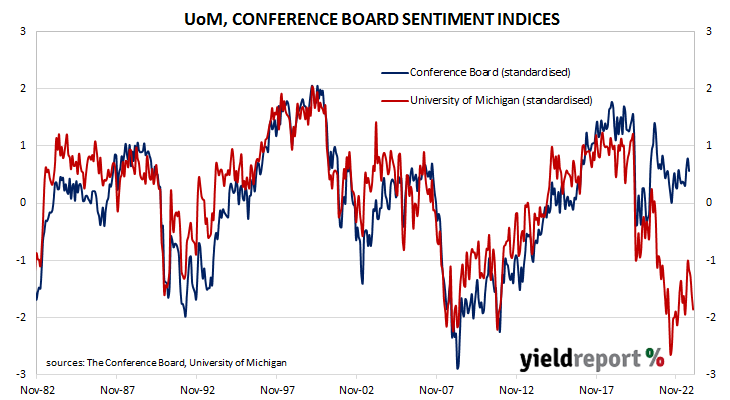Summary: Conference Board Consumer Confidence Index rises slightly in November, reading more than expected; improvement mostly from respondents aged 55+; Treasury yields fall; Fed rate-cut expectations for 2024 harden; view of present conditions deteriorate, short-term outlook improves; Citi: consumption to grow, albeit at more modest pace.
US consumer confidence clawed its way back to neutral over the five years after the GFC in 2008/2009 and then went from strength to strength until late 2018. Measures of consumer confidence then oscillated within a relatively narrow band at historically high levels until they plunged in early 2020. Subsequent readings then fluctuated around the long-term average until March 2021 when they returned to elevated levels. However, a noticeable gap has since emerged between the two most-widely followed surveys.
The latest Conference Board survey held during the first half of November indicated US consumer confidence has improved slightly after deteriorating for the previous three months. November’s Consumer Confidence Index registered 102.0 on a preliminary basis, above the generally-expected figure of 101.0 as well as October’s final figure of 99.1.
“November’s increase in consumer confidence was concentrated primarily among householders aged 55 and up; by contrast, confidence among householders aged 35-54 declined slightly,” said Dana Peterson, Chief Economist at The Conference Board. “General improvements were seen across the spectrum of income groups surveyed in November.”
US Treasury yields finished the day lower, especially at the short end. By the close of business, the 2-year Treasury bond yield had shed 15bps to 4.74%, the 10-year yield had lost 5bps to 4.33 while the 30-year yield finished 2bps lower at 4.51%.
In terms of US Fed policy, expectations of a lower federal funds rate in the next 12 months hardened. At the close of business, contracts implied the effective federal funds rate would average 5.335% in December, in line with the current spot rate, 5.335% in January and 5.31% in March. November 2024 contracts implied 4.50%, 83bps less than the current rate.
Consumers’ views of present conditions deteriorated slightly while views of the near-future improved. The Present Situation Index declined from October’s revised figure of 138.6 to 138.2 while the Expectations Index moved up from 72.7 to 77.8.
“Despite somewhat lower confidence numbers over the summer, consumption growth increased at a rapid pace in the third quarter, and we expect consumption will continue to grow into the end of the year, albeit at a more modest pace,” said Citi analyst Gisela Hoxha.
The Consumer Confidence Survey is one of two widely followed monthly US consumer sentiment surveys which produce sentiment indices. The Conference Board’s index is based on perceptions of current business and employment conditions, as well as respondents’ expectations of conditions six months in the future. The other survey, conducted by the University of Michigan, is similar and it is used to produce an Index of Consumer Sentiment. That survey differs in that it does not ask respondents explicitly about their views of the labour market and it also includes some longer-term questions.



